
The United States Naval Observatory (USNO) is a scientific and military facility that produces geopositioning, navigation and timekeeping data for the United States Navy and the United States Department of Defense. Established in 1830 as the Depot of Charts and Instruments, it is one of the oldest scientific agencies in the United States, and remains the country's leading facility for astronomical and timing data.

Matthew Fontaine Maury was an American oceanographer and naval officer, serving the United States and then joining the Confederacy during the American Civil War.
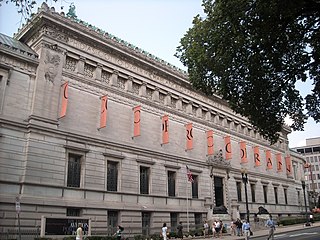
Foggy Bottom is a neighborhood of Washington, D.C., United States, located in the city's northwest quadrant. It stretches west of the White House towards the Potomac River, north of the National Mall, east of Georgetown, south of the West End neighborhood and west of Downtown D.C.

Capitol Hill is a neighborhood in Washington, D.C., located in both Northeast D.C. and Southeast D.C.. Bounded by 14th Street SE & NE, F Street NE, Southeast Boulevard SE, South Capitol Street SE. Dominated by the United States Capitol, which sits on the highest point of Capitol Hill, it is one of the oldest historic districts in Washington. Home to around 35,000 people in just under 2 square miles (5 km2), Capitol Hill is also one of the most densely populated neighborhoods. The name "Capitol Hill" is frequently used as a metonym for the U.S. Congress.
Horace Parnell Tuttle was an American astronomer, an American Civil War veteran and brother of astronomer Charles Wesley Tuttle.

The Walter Reed Army Medical Center (WRAMC), officially known as Walter Reed General Hospital (WRGH) until 1951, was the U.S. Army's flagship medical center from 1909 to 2011. Located on 113 acres (46 ha) in Washington, D.C., it served more than 150,000 active and retired personnel from all branches of the United States Armed Forces. The center was named after Walter Reed, a U.S. Army physician and Major who led the team that confirmed that yellow fever is transmitted by mosquitoes rather than direct physical contact.

The Leander McCormick Observatory is one of the astronomical observatories operated by the Department of Astronomy of the University of Virginia, and is situated just outside Charlottesville, Virginia (US) in Albemarle County on the summit of Mount Jefferson. It is named for Leander J. McCormick (1819–1900), who provided the funds for the telescope and observatory.
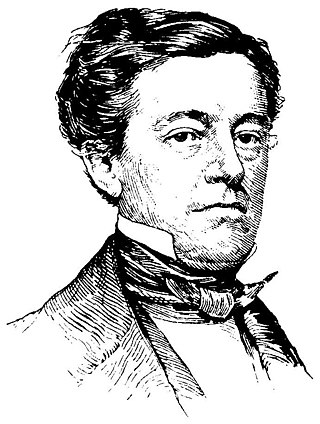
James Melville Gilliss was an astronomer, United States naval officer and founder of the United States Naval Observatory.
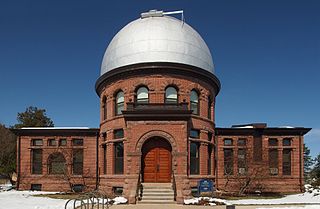
Goodsell Observatory is an observatory at Carleton College in Northfield, Minnesota, United States. It was constructed in 1887 and was, at the time, the largest observatory in the state of Minnesota, the 6th largest in the U.S., and the 12th largest in the world. The Goodsell Observatory and its predecessor, a smaller observatory that opened in 1878, served as a widely consulted timekeeping station, bringing national prominence to Carleton College in the late 19th and early 20th centuries.

The National Observatory of Athens is a research institute in Athens, Greece. Founded in 1842, it is the oldest research foundation in Greece. The Observatory was the first scientific research institute built after Greece became independent in 1829, and one of the oldest research institutes in Southern Europe. It was built around the same period as the United States Naval Observatory.

The Old University of Alabama Observatory, now known as Frederick R. Maxwell Hall, was an astronomical observatory owned and operated by the University of Alabama in Tuscaloosa, Alabama. Although no longer used as an observatory, the building has been restored and preserved. It currently houses the university's Collaborative Arts Research Initiative (CARI), an interdisciplinary, arts-focused research engine driven by the interests of faculty from across the university. By facilitating collaborations across disciplines, CARI maximizes the impact of faculty arts research, while enriching the university, local, and regional communities. Significant for its architectural and historical importance, it was added to the National Register of Historic Places on January 14, 1972.
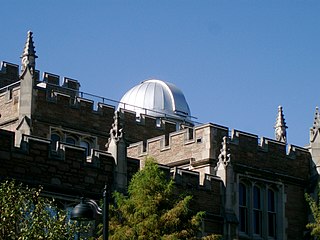
Crow Observatory is a historic observatory housed in the Crow Hall in the Physics Department on the Danforth Campus of Washington University in St. Louis. The historic telescope is still in use, and the observatory is open to the public.

The Dearborn Observatory is an astronomical observatory located on the Evanston campus of Northwestern University. The observatory was originally constructed in 1888, through an agreement between the university and the Chicago Astronomical Society. In the summer of 1939, Dearborn Observatory had to be moved to make way for the construction of the Technological Institute.
Washington, D.C., is the capital city and federal district of the United States. Below is a list of Washington, D.C.-related articles.

Barnard Observatory is an academic building at the University of Mississippi in Oxford, Mississippi. Completed as an observatory in 1859, it was part of the astronomy focus that chancellor Frederick A.P. Barnard had for the school. Due to the outbreak of the Civil War, though, the purchase of the observatory's telescopes were put on hold. Today the observatory houses the Center for the Study of Southern Culture while the university's astronomers use Kennon Observatory.
The campus of the George Washington University (GW), originated on College Hill, a site bounded by 14th Street, Columbia Road, 15th Street and Florida Avenue, NW in the Columbia Heights neighborhood of Washington, D.C. After relocating to the downtown financial district in the 1880s and then to Foggy Bottom in 1912, GW now has three campuses. Foggy Bottom is the location of the university's main campus in Washington, D.C. Also in Washington's Foxhall neighborhood is the Mount Vernon Campus, formerly the Mount Vernon College for Women. Additionally, the George Washington University Virginia Campus is located in Ashburn, VA.
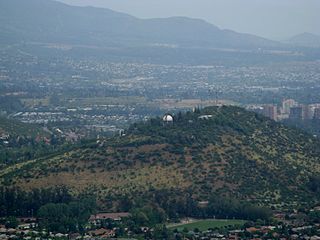
The National Astronomical Observatory of Chile is an astronomical observatory owned and operated by the Department of Astronomy of the University of Chile (UCh). It is located on Cerro Calán, a hill in the commune of Las Condes. The commune is an eastern suburb of Santiago located in Santiago Province of the Santiago Metropolitan Region. OAN was founded in 1852 and became a part of UCh in 1927. The facility on Cerro Calán was completed in 1962.

Brooklyn Naval Hospital was a hospital in Brooklyn, New York City, within the Brooklyn Navy Yard. It was one of the oldest naval hospitals in the United States, having operated from 1838 to 1948. Two of the structures in the former hospital's site are designated New York City Landmarks. The entire hospital complex is listed on the National Register of Historic Places along with the rest of the Navy Yard.

Naval Support Activity Hampton Roads is a United States Navy Echelon 4 regional support commander that is responsible to Navy Region Mid-Atlantic for the operation and maintenance of the installation of the same name that it is headquartered on. Adjacent to, but separate from Naval Station Norfolk, NSA Hampton Roads has the largest concentration of fleet headquarters administrative and communication facilities outside of Washington, D.C., including the headquarters for United States Fleet Forces Command, Naval Reserve Forces Command and United States Marine Corps Forces Command, along with components of the Joint Chiefs of Staff, and the home campus for the Joint Forces Staff College. NSA Hampton Roads is also home to NATO’s Joint Force Command Norfolk and NATO's Allied Command Transformation.

The E Street Complex, also known as the "Navy Hill Complex," the "Potomac Hill Complex," the "Observatory Hill Complex," and the "Pickle Factory," is the historic site of the primary headquarters facility of the Office of Strategic Services, and the first headquarters building of the Central Intelligence Agency. It is geographically located near 23rd Street and E Street in Washington, D.C. This complex was unassuming, appearing to be a mix of normal government offices and apartment buildings to nearby residents and office workers.





















